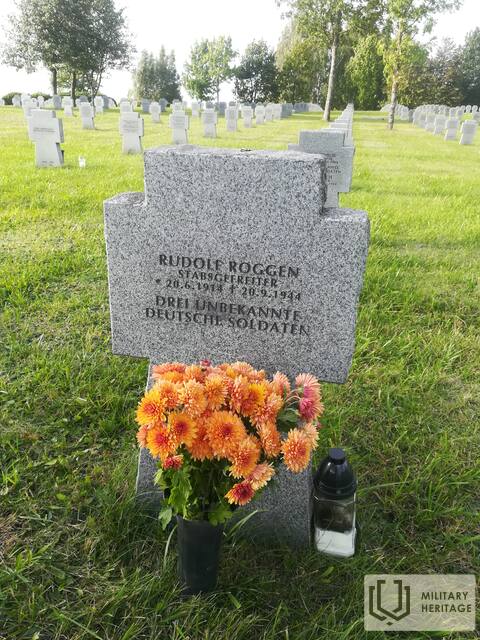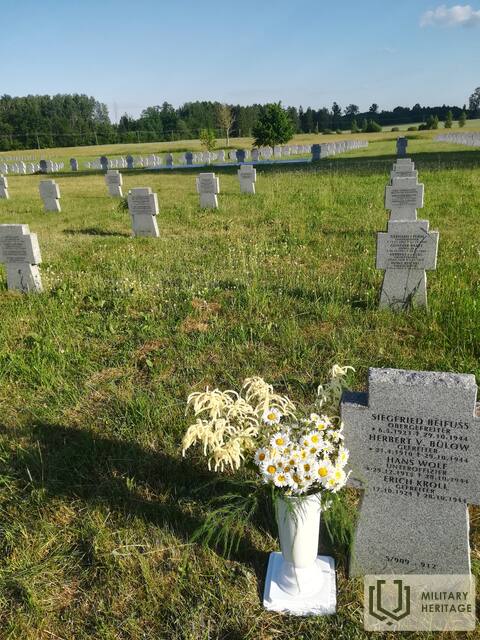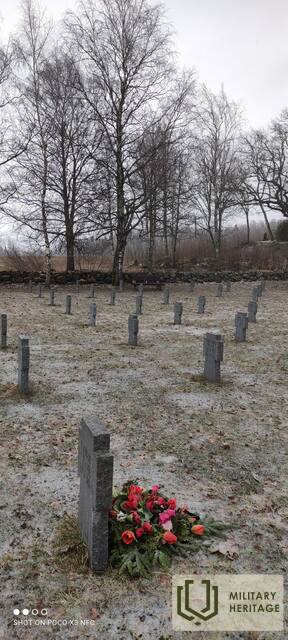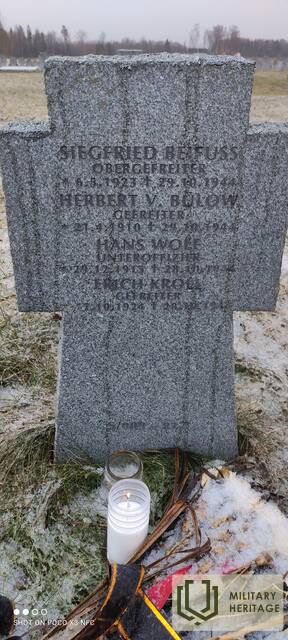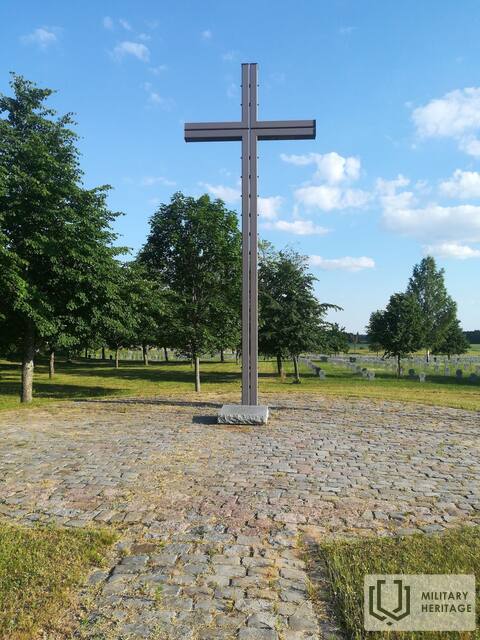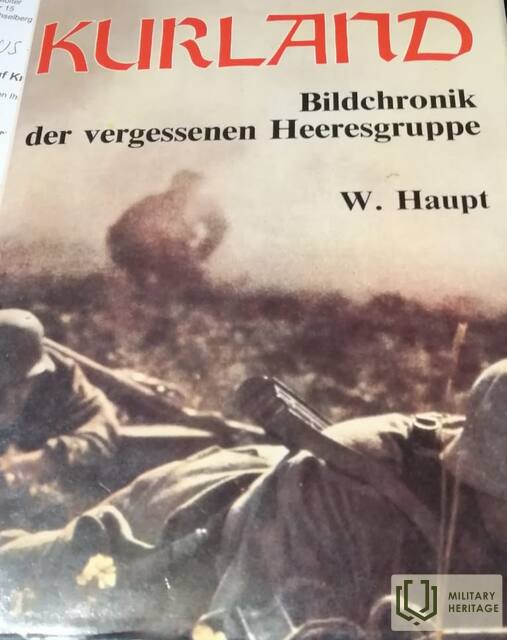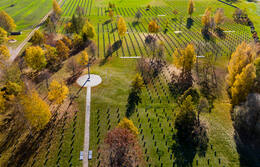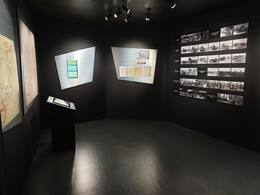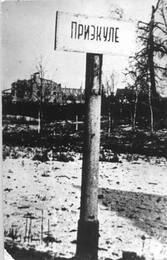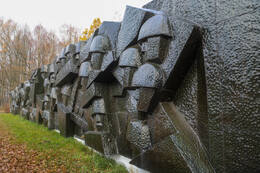„Karas nesibaigia, kol nepalaidotas paskutinis kareivis“ (Saldus vokiečių kareivių kapinės)
Kuržemė kaip atskiras ir savitas mūšio laukas iškilo 1944 m. spalio 10 d. Buvo suskaičiuota, kad apsuptyje buvo apie 500 000 vokiečių karių. Remiantis 1-ojo Baltijos fronto štabo pranešimais, norint visiškai išlaisvinti visą Baltijos pakrantę, reikėjo tik „nedidelių pastangų“. Tačiau kovos Kurše tęsėsi dar septynis mėnesius, ir Kurše tapo Antrojo pasaulinio karo pabaigos simboliu.
Per septynis kovos mėnesius iki 1945 m. gegužės mėn. vokiečių pajėgos Kurše neteko 154 108 žuvusių, sužeistų ir dingusių be žinios kareivių. Nuo 1997 m. netoli Saldus atliktas karo kapinių tyrimas ir perlaidojami kareiviai, o šiuo metu čia galima rasti 27 000 žuvusių kareivių vardų.
Kuržemė kaip atskiras ir savitas mūšio laukas iškilo 1944 m. spalio 10 d. Raudonoji armija nuo 1944 m. liepos pabaigos bandė pasinaudoti sėkme Baltarusijoje, kur per mažiau nei mėnesį buvo sunaikinta vokiečių armijų grupė „Centras“. 1944 m. rugpjūčio pradžioje sovietų 3-iojo gvardijos mechanizuotojo korpuso daliniai užėmė Tukumą ir pasiekė Klapkalnciją Rygos įlankoje, nutraukdami sausumos eismą tarp Vermachto armijų grupės „Šiaurė“ ir Vokietijos. Tačiau pirmasis Raudonosios armijos bandymas nutraukti eismą buvo nesėkmingas, nes vokiečių kontrataka lėmė sausumos koridoriaus netoli Tukumo atkūrimą jau 1944 m. rugpjūčio pabaigoje.
Kitas bandymas apsupti vokiečių armiją prasidėjo 1944 m. rugsėjo 14 d., kai trys Baltijos frontai su 1 546 000 karių pradėjo puolimą Rygos link. Šis bandymas taip pat buvo nesėkmingas ir Raudonoji armija turėjo pakeisti savo planus. Trečiasis bandymas, žinomas kaip „Kalifornijos puolimas“, buvo ne tik sėkmingas, bet ir tapo vienu didžiausių Raudonosios armijos pasiekimų Antrojo pasaulinio karo metu. 5-oji tankų armija, pradėjusi puolimą spalio 5 d., spalio 10 d. vakare pasiekė Baltijos jūros pakrantę netoli Palangos.
Apskaičiuota, kad apsuptyje buvo apie 500 000 vokiečių karių. Remiantis 1-ojo Baltijos fronto štabo pranešimais, norint visiškai išlaisvinti visą Baltijos pakrantę, reikėjo tik nedidelių pastangų. Tačiau kovos Kurše tęsėsi dar septynis mėnesius ir Kuršas tapo Antrojo pasaulinio karo pabaigos simboliu.
Per septynis kovos mėnesius iki 1945 m. gegužės mėn. vokiečių pajėgos Kurše neteko 154 108 žuvusių, sužeistų ir dingusių be žinios kareivių. Tikslus žuvusiųjų ir dingusiųjų skaičius nežinomas, tačiau galėjo siekti 50 000. Pasibaigus karui, sovietai sunaikino vokiečių kareivių kapines. Žuvusių kareivių ekshumacija iš mūšio laukų ir sugriautų kapinių prasidėjo XX a. dešimtojo dešimtmečio pradžioje.
Nuo 1997 m. pradėti Saldaus apylinkių karo kapų tyrimai ir perlaidojimas, šiuo metu čia galima rasti 27 000 žuvusių karių vardų. Darbas vis dar tęsiasi, nes dar ne visos laidojimo vietos yra ištirtos. Perlaidotų karių vardai rodo, kad į Vokietijos kariuomenę, be vokiečių ir austrų, taip pat buvo pašaukti latviai, estai, lietuviai, norvegai, danai ir kitų tautybių žmonės.
Susijusi laiko juosta
Susijusios vietos
Saldaus vokiečių kareivių kapinės
Saldaus vokiečių kareivių kapinės yra prie Saldaus–Ežerės plento. Kapinėse, užimančiose 8 hektarų plotą, yra apie 25 000 vokiečių kareivių, taip pat kai kurių Latvijos legionierių palaikai. Perlaidojimai vyksta nuo 1997 m.
Nuo gegužės 1 d. iki spalio 1 d. memorialiniame kambaryje galima apžiūrėti parodą apie Kuršo mūšius. Šiuo laikotarpiu memorialinis kambarys dirba darbo dienomis nuo 9:00 iki 17:00 val., o šeštadieniais ir sekmadieniais kapinėse dirba ir gidas. Taip pat galima susipažinti su Saldaus vokiečių kareivių kapinėse palaidotų ir visoje Latvijoje žuvusių kareivių sąrašais.
Ezerės kraštotyros saugykla „Muitas Nams“
Ezerės muitinė yra Ezerėje, netoli Saldaus-Mažeikių plento, Latvijos ir Lietuvos pasienyje. 1945 m. gegužės 8 d. šiame pastate buvo pasirašytas vadinamojoje „Kuršo kišenėje“ apsuptų Vokietijos armijos dalinių „Kurzeme“ (Kurlandas) kapituliacijos aktas. Manoma, kad Antrasis pasaulinis karas iš tikrųjų baigėsi Ezerėje. Muitinėje yra ekspozicija, kurioje aprašomi Antrojo pasaulinio karo pabaigos įvykiai, ir eksponatai, kuriuose išsamiai aprašoma Ezerės parapijos istorija nuo seniausių laikų iki šių dienų. 1945 m. gegužės 7 d. rytą Leningrado fronto vadas maršalas L. Govorovas išsiuntė armijų grupės „Kurzeme“ vadovybei ultimatumą sudėti ginklus. Kapituliacijos aktą susijusios šalys pasirašė gegužės 8 d., jame išsamiai aprašyta perdavimo tvarka, ginklų surinkimo punktai, pateiktini dokumentai ir informacija bei kitos praktinės priemonės.
Hermanno Faulo atminimo vieta
Jis įsikūręs kaimo kelių sankryžoje, nukrypus nuo kelio, vedančio iš Pienavos į Džūkstę.
Paminklas H. Faului ir devyniems vokiečių bei latvių kareiviams, žuvusiems 1944 m. gruodžio 27 d. mūšyje (tikriausiai susprogdinus juos tiesiogiai pataikius patrankos sviediniui) ir nuo to laiko laikomi dingusiais be žinios, nes nerasta jokių jų palaikų, dokumentų ar kitų tapatybės įrodymų.
Priekulės karių kapinių memorialinis ansamblis
Priekulės karių kapinių memorialinis ansamblis yra Liepojos-Priekulės-Skodos kelyje ir yra didžiausia Antrojo pasaulinio karo sovietų karių laidojimo vieta Baltijos šalyse. Čia palaidota daugiau nei 23 000 sovietų karių. Operacija „Priekulė“ buvo vienas įnirtingiausių mūšių Kuržemės tvirtovėje, vykęs nuo 1944 m. spalio iki 1945 m. vasario 21 d. Priekulės mūšis 1945 m. vasarį truko septynias dienas ir naktis be perstojo ir pareikalavo daug aukų abiejose pusėse. Iki Priekulės karių kapinių pavertimo memorialu čia buvo pastatytas paskutinis iškilaus latvių skulptoriaus K. Zālės (1888–1942) paminklas, skirtas Alojos nepriklausomybės kovoms atminti. Nuo 1974 iki 1984 m. 8 ha Priekulės karių kapinės buvo paverstos memorialiniu ansambliu, skirtu Antrojo pasaulinio karo žuvusiems. Jį suprojektavo skulptorius P. Zaļkalne, architektai A. Zoldners ir E. Salguss bei dendrologas A. Lasis.
Memorialo centre stovi 12 m aukščio statula, vadinama „Tėvyne“, o žuvusiųjų vardai iškalti granito plokštėse. Iki Latvijos nepriklausomybės atgavimo Pergalės diena buvo plačiai švenčiama kasmet gegužės 9 d.




